SIPs are Structurally Strong
Part 1: SIPs are Strong
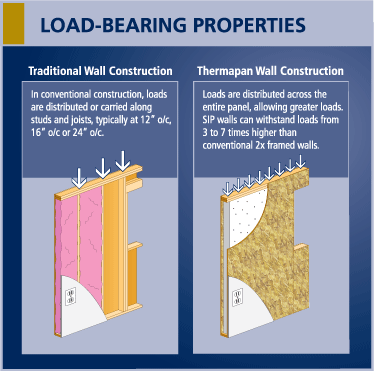 SIPs are stronger than wood frame construction. Consider that in conventional framing, load are distributed along 2×6 studs spaced 12″, 16″ or even 24″ o/c. That’s why traditional construction is often referred contemptibly as “stick-built”.
SIPs are stronger than wood frame construction. Consider that in conventional framing, load are distributed along 2×6 studs spaced 12″, 16″ or even 24″ o/c. That’s why traditional construction is often referred contemptibly as “stick-built”.
When you build with SIPs, the same loads are evenly distributed across the entire panel, making your home structurally superior to traditional stud framing.
Part 2: Withstanding Extreme Events
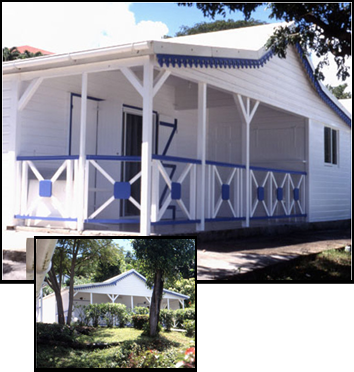 SIP homes have withstood the force of hurricanes, tornados and earthquakes. The Thermapan-built, 21,000 sq ft Jacques Cousteau Diving Village in Guadeloupe remained intact through three of the strongest hurricanes of the past quarter century: Hurricanes Andrew, Hugo and Mitch.
SIP homes have withstood the force of hurricanes, tornados and earthquakes. The Thermapan-built, 21,000 sq ft Jacques Cousteau Diving Village in Guadeloupe remained intact through three of the strongest hurricanes of the past quarter century: Hurricanes Andrew, Hugo and Mitch.
Part 3: Dimensionally Stable
SIPs are dimensionally stable. They are not prone to moisture that can undermine the integrity of concrete and wood framing.
Concrete wall and foundation systems crack resulting in potential increased air and moisture leakage. Wood frame structures shrink and bend resulting in potential increased air leakage and uneven finishing services.
Risks facing structural systems
| Concrete | Wood Framing | SIPs | |
| Cracking | Yes | ||
| Shrinking | Yes | Yes | |
| Bending | Yes | ||
| High Moisture Diffusion Rate | Yes | Yes |
Superior Insulation
Part 1: The Six Mechanisms of Heat Loss
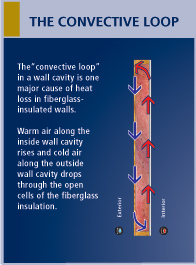 The role of insulation is to minimize or eliminate the occurrence of heat loss in a building or home. This can be more complicated than it appears, especially considering there are six mechanisms of heat loss that can come into play.
The role of insulation is to minimize or eliminate the occurrence of heat loss in a building or home. This can be more complicated than it appears, especially considering there are six mechanisms of heat loss that can come into play.
Conduction – the transfer of heat within an object or between two objects that are in contact. A pot gets its heat from contact with the stove element.
Convection – the transfer of heat that occurs when a liquid or gas comes into contact with a material of a different temperature and distributes heat accordingly. Hot air rises since it is less dense than cold air, moving heat upward, while cold air falls.
Radiation – the transfer of heat by means of electro-magnetic waves. The Earth gets its heat from the Sun exclusively via radiation, because the void of space in between the two prevents both conduction and convection.
Conduction, convection and radiation are the three primary scientific mechanisms of heat transfer. But there are also three secondary mechanisms at play in building science.
Air Infiltration – the transfer of heat when air pressure differences between the exterior and interior force air to infiltrate a building. A strong wind will often “push” unconditioned exterior air inside a building.
Air Intrusion – when exterior air infiltrates a wall cavity but doesn’t continue into the building, exiting back to the outside instead. While there is no draft felt inside, the thermal patterns inside the wall insulation are affected.
Moisture Accumulation – when moisture permeates an insulation material, it will reduce the insulation’s effectiveness, contributing to heat loss/gain.
Part 2: Closed Cell vs. Open Cell Insulation
 While there are a multitude of products on the market, there are two basic types of insulation: open cell and closed cell. Insulations like fiberglass and low-density urethane spray foam are OPEN CELL insulations because the air pockets are not fully enclosed. Air and moisture can enter and escape the system freely. The cells are “broken” and air can fill or escape the space inside the material. This lowers the insulation performance properties and explains why they usually cost less.
While there are a multitude of products on the market, there are two basic types of insulation: open cell and closed cell. Insulations like fiberglass and low-density urethane spray foam are OPEN CELL insulations because the air pockets are not fully enclosed. Air and moisture can enter and escape the system freely. The cells are “broken” and air can fill or escape the space inside the material. This lowers the insulation performance properties and explains why they usually cost less.
In comparison, expanded polystyrene (EPS) used in Thermapan SIPs is a CLOSED CELL insulation where air cannot enter and escape at all and the insulation performance properties are unchanged.
There are numerous advantages of closed-cell insulation compared to open-cell:
- higher R-value
- high density = strength
- greater resistance to air or water vapour penetration
- resists all six mechanisms of heat loss
Part 3: Closed Cell Insulation vs. the six mechanisms of heat loss
The “broken” nature of open cell insulation invites heat loss from all six mechanisms of heat loss. The open cells provide a natural environment for air and moisture to infiltrate, exfiltrate and circulate within the insulation.
Whereas the R-Value of an insulation is measured exclusively by its ability to resist heat transfer via conduction, in reality its true insulative properties are much weaker due to heat loss from the other five mechanisms.
The key to SIPs is that there is no wall cavity. The EPS insulation is rigid and solid, unlike the porous nature of traditional fiberglass and open cell spray foam.
Consequently, SIPs can truly claim to eliminate thermal transfer from the other five mechanisms. There is no convective loop, air infiltration or air intrusion, because SIPs are a true air barrier – the solid insulation prevents air from circulating. Likewise there is no thermal transfer resulting from moisture accumulation, as SIPs are a vapour barrier as well. Finally, radiative heat transfer, which occurs in the void of space, is negligible. While in theory heat can transfer by radiation within a cell in the insulation, its adjoining cell walls are essentially at the same temperature anyway.
Part 4: The Proof is in the Performance
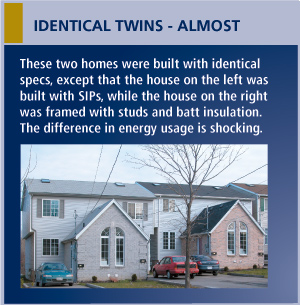 The critical role played by the six mechanisms of heat loss can be demonstrated through various real-world studies.
The critical role played by the six mechanisms of heat loss can be demonstrated through various real-world studies.
One very revealing study was conducted by Brock University researchers, who had the opportunity to analyze temperature variances within the exterior walls of two nearly identical houses – one using traditional R-19 fiberglass insulation and the other built with SIPs that featured an R-17 foam-based EPS insulation.
If energy loss in a home was simply a matter of heat transfer via conduction, one would expect very little difference in energy usage between the two homes. After all, the rated differences between the insulations of the two homes was a mere R-2.
However, the study found that the R-17 EPS outperformed the R-19 fiberglass hands down, and highlighted a number of interesting findings:
- During the month of January 2001, the average temperature of R-19 fiberglass was -5ºC (23ºF) when the outdoor temperature was -10.5ºC (13.1ºF).
- The SIP wall house with R-17 EPS insulation maintained its true R-value throughout the duration of the 1 year study.
- The R-17 EPS SIP wall house used 33% less energy than the R-19 fiberglass wall house.
The Brock University study clearly demonstrates that other mechanisms besides thermal conduction are at play in a real world setting. Otherwise the two homes would experience similar energy usage.
The proof is in the performance. When it comes to choosing an insulation for a new home or commercial building, it’s imperative to look beyond the stated R-Value of the material under consideration. Of far greater importance is the nature of the insulation, particularly its microscopic cell structure. An insulation with closed cells, like the EPS used in Thermapan SIPs, will invariably resist heat loss stemming from all six mechanisms far more effectively than open cell insulations.
A True Air Barrier
Part 1: Purpose of an Air Barrier
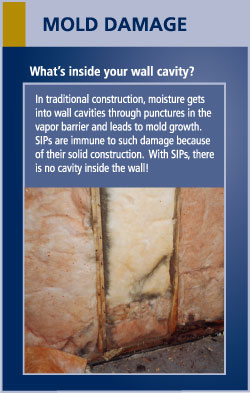 An air barrier is a critical component in homebuilding. By controlling air leakage into and out of the building envelope, an air barrier helps prevent energy loss and reduces uncomfortable drafts.
An air barrier is a critical component in homebuilding. By controlling air leakage into and out of the building envelope, an air barrier helps prevent energy loss and reduces uncomfortable drafts.
But there is much more to an air barrier. That’s because air not only carries heat, but it also carries moisture.
Building envelopes with open cell insulation have an internal atmosphere, permitting moisture to accumulate. Condensation can occur when the temperature inside the wall cavity reaches the dew point. Moisture is trapped as water crystals, and subject to repeated thaw-and-freeze cycles. The long term result: mold.
This phenomenon takes place even when an air barrier is installed. The problem is that the integrity of the air barrier is typically compromised by unsealed seams, staples, screws and punctures for electrical and plumbing.
Part 2: SIPs: A True Air Barrier
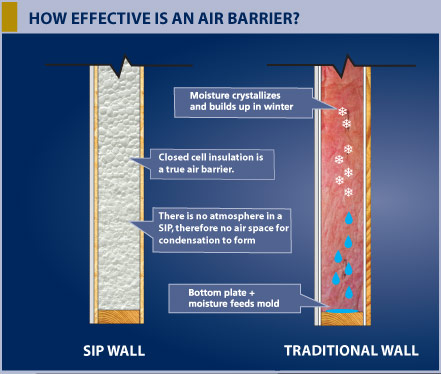 A SIP is a true air barrier and condensation can never form in a SIP. The simple reason is because a SIP uses closed cell insulation and has no atmosphere or air space for the condensation to form.
A SIP is a true air barrier and condensation can never form in a SIP. The simple reason is because a SIP uses closed cell insulation and has no atmosphere or air space for the condensation to form.
Even when a SIP wall is subject to electrical and plumbing punctures, the integrity of the closed cell insulation remains intact. As a result, air and moisture cannot enter the system, eliminating the potential for mold growth.
Up to 40% in Labour Savings
Part 1: A Single Envelope Component
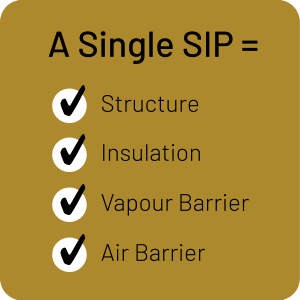 Thermapan’s standard SIP foundation wall, exterior wall, roof and floor building systems provide residential and commercial builders an efficient advantage over conventional on-site construction methods. The Thermapan SIP system permits faster installation, less job site waste, and superior quality and performance.
Thermapan’s standard SIP foundation wall, exterior wall, roof and floor building systems provide residential and commercial builders an efficient advantage over conventional on-site construction methods. The Thermapan SIP system permits faster installation, less job site waste, and superior quality and performance.
The Thermapan SIP system reduces construction time because when SIPs are installed the structure, insulation, vapour barrier and air barrier building envelope components are achieved. Alternative on-site conventional construction methods involve building envelope components that must be installed individually, requiring more time.
Part 2: Higher Quality = Fewer Callbacks
 Thermapan SIPs are accurate, plumb and are inert to dimensional shrinkage unlike wood frame methods. The continuous SIP flat surface is advantageous for interior and exterior cladding applications; reduces construction defects and provides superior building serviceability for the expected service life of the building.
Thermapan SIPs are accurate, plumb and are inert to dimensional shrinkage unlike wood frame methods. The continuous SIP flat surface is advantageous for interior and exterior cladding applications; reduces construction defects and provides superior building serviceability for the expected service life of the building.
Part 3: Job Site Efficiency & Flexibility
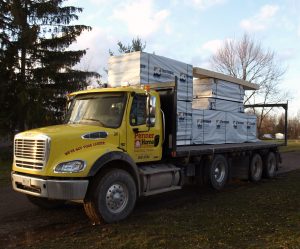 The Thermapan SIP standard panel system is packaged wrapped for weather protection. Each SIP package is individually labeled listing the contents resulting in a more organized construction site. Less time is needed for sorting and assembly starts immediately.
The Thermapan SIP standard panel system is packaged wrapped for weather protection. Each SIP package is individually labeled listing the contents resulting in a more organized construction site. Less time is needed for sorting and assembly starts immediately.
The Thermapan SIP standard panel building system is flexible to address project variables that occur frequently without effecting your bottom line. Such variables include overall building dimensions revisions, window/door opening dimensions and locations.
